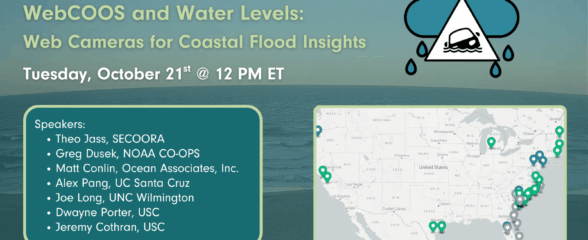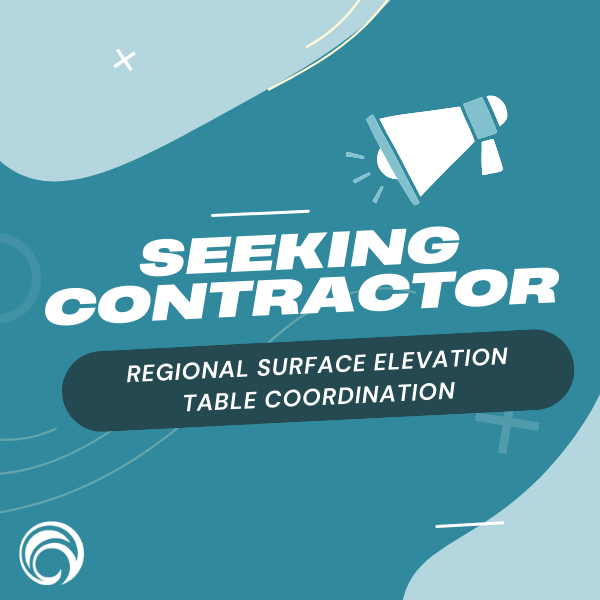SECOORA is seeking a contractor to provide coordinator services including 1) develop an inventory of existing Surface Elevation Tables (SETs); 2) conduct a SET gap analysis; and 3) develop and foster a SET Community of Practice, including facilitating a workshop and virtual meetings and developing web content.
SETs are used to measure the changes in elevation of wetlands, such as coastal marshes. SETs, once a long-term record has been established, help determine if a marsh is retaining enough sediment to keep up with sea level rise or if it is being “drowned”. The Southeast coastal zone managers have requested additional SET monitoring stations across the region to increase data available on marsh resilience to sea level change. Currently there is no regional coordination on SET installation or data management in the Southeast.
This scope of work is to provide regional coordination for two years, with an opportunity to continue beyond the 2 years (contingent on funding). The anticipated start date for the SET contractor is February 2023. The successful contractor is able to work remotely but will need to be available via phone during normal working hours.
Contractor Responsibilities
Year 1
- Develop a comprehensive regional inventory of SETs in NC, SC, GA, and FL. This will involve setting up a framework for information to be collected for each station (location, date installed, owner, etc.) and researching online and in publications and reaching out to various organizations to gather information.
- Work with experts in each state to conduct a gap analysis by mapping stations, reviewing the geographic scope of SETs with regional experts, and assessing specific areas of concern through discussion with coastal and estuarine managers. Some of the priority locations that come out of this gap analysis will be funded during year 2 and subsequent years (contingent on funding).
- Formalize a team of regional experts and develop and facilitate a community of practice (CoP) focused on sharing best practices and creating new knowledge around the data and its applications.
Year 2:
- Develop content for a basic web page for the SET CoP and work with the SECOORA Communications Director to keep it updated as needed.
- Continue to facilitate the CoP through hosting virtual meetings.
- Assist SECOORA with defining the data management needs for SET data, and contracting with a data management team to ingest standardized SET data and draft metadata requirements for the data.
- Host a 2-day regional SET CoP workshop focused on standardized SET station installation protocols, data formats and metadata, demonstration of the SET data portal, and uploading/sharing of SET data. SECOORA will fund the installation of 16 SETs to fill gaps. Based on the gap analysis and workshop outcomes, assist representatives from NC, SC, GA, and FL to prioritize 16 SETS installations (4 stations in each state). Funding will be provided to each state to complete the installations. Track installation status and notify CoP as installations are completed.
The contract offer will be based on the successful candidate’s qualifications and experience. Anticipated workload is approximately 20 hours per week during Year 1 and about 10 hours per week in Year 2.
Application deadline is January 18, 2023 at 5pm ET.
Related news

SECOORA Webinar | WebCOOS and Water Levels: Web Cameras for Coastal Flood Insights
On October 21st at 12 PM ET, SECOORA is hosting a webinar with investigators from the Webcam Coastal Observation System (WebCOOS) project team and the WebCOOS Project Manager. Web cameras are a low-cost technology that can be used to document flooding impacts to coastal communities. Register here.

SECOORA Funding Opportunity Announcement: Letters of Intent Solicitation
SECOORA will submit a coordinated regional proposal in response to the anticipated FY 2026 Implementation of the U.S. Integrated Ocean Observing System (IOOS) funding opportunity. Letters of Intent to be considered for inclusion in SECOORA’s full proposal are due September 9, 2025.

SECOORA Hosts the First Surface Elevation Table (SET) Community of Practice Virtual Workshop
The SECOORA SET Workshop was virtual on July 17, 2025. More than 50 Community of Practice members and stakeholders joined this collaborative workshop to discuss SET monitoring, coastal resilience, and data-driven decision making in the Southeast.
